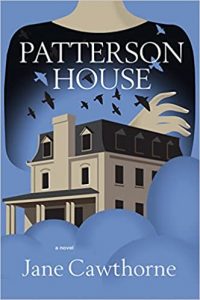A Long Road to Publication for Jane Cawthorne’s Patterson House
A Long Road to Publication for Jane Cawthorne’s Patterson House
 The road to publication for Patterson House, my first novel, has been rocky. What is It about this story that drove me forward for the better part of two decades and through so many obstacles?
The road to publication for Patterson House, my first novel, has been rocky. What is It about this story that drove me forward for the better part of two decades and through so many obstacles?
I think it was the main characters. In Patterson House, Alden, the last surviving member of a once wealthy Toronto family, is haunted by the legacy of her grandfather, William Patterson, whose suicide taints the family name. Living in the decaying Patterson House with Constance, a foundling, and John Hunt, an injured war veteran, Alden is reduced to taking in boarders to survive. When the crash of 1929 leaves her truly desperate, a new and mysterious boarder arrives who threatens everything she has.
When I started writing Patterson House, it was a short story and Constance was the main character. But Alden, a formidable woman with a mind of her own, took over the narrative and I had to let her. That was my first lesson in going along with the unexpected. Alden and Constance are dual main characters now. What I hadn’t understood back then was that Alden herself would become a role model in fortitude for me. Both Alden and Constance show how brave women can defy convention, refuse the life that is expected of them, and carry on despite many setbacks.
Having never written a novel before, I had much to learn. I gave up two or three times but had an opportunity to get an MFA in Creative Writing and find some mentorship at the Solstice Creative Writing Program in Boston. I emerged from two years of study and writing with an almost complete manuscript. An agent was interested. I told her I could have the work polished in three months, an estimate I thought was conservative.
Then, I was in a car accident. A seemingly minor concussion turned into an odyssey I am still grappling with today. I had to learn so many things again—how to get my eyes and brain to communicate, how to read, and ultimately, how to write with this altered brain of mine. As I did this, I co-edited an anthology with E. D. Morin, Impact: Women Writing After Concussion (University of Alberta Press) in which twenty-one women writers describe their lives and creative process after traumatic brain injury. Creating that book got me to work again in an incredibly supportive environment.
In the essay I contributed to Impact, I wrote about all the ways I was lost after the accident. My novel was lost too, possibly forever. I wrote, “For a long time, I missed my novel and my characters. I imagined them sitting in a blank, white room, waiting, drumming their fingers and rolling their eyes. Eventually, they faded. I imagined they got bored and left. Drifted away. They evaporated into the ether. I kept them waiting too long. In a way, they were lost too. It was years before I could find them again.”
I couldn’t explain it in that essay, but Alden wasn’t just bored waiting for me; she was impatient. She didn’t drift away. She stormed out. Constance was a little more understanding. But they both came back to me, eventually. Finally, a little more than three years after the accident and a lot of rehabilitation, I was able to put the finishing touches on Patterson House.
Unsurprisingly, the agent was no longer interested and very kindly declined. I continued to look for an agent and came close to landing one twice. The last time, the agent quit their agency via Twitter while we were negotiating my contract. I began to wonder if Patterson House would ever make it to publication.
Ultimately, I decided to submit on my own. It was a happy day when Inanna offered me a contract. I had published Writing Menopause with Inanna (another anthology I co-edited with E. D. Morin), and knew their Editor-in-Chief, Luciana Ricciutelli, to be a talented editor with a keen eye. Her confidence in the work bolstered my confidence in it. Alden, Constance and Patterson House would be in good hands.
And then the pandemic started. Inanna’s schedule was delayed by a year. At least. Luciana sent a detailed letter explaining the chaotic state of the industry and Inanna’s difficult decision. It was not at all unusual—even major motion pictures were being delayed.
And then, the unthinkable happened. Luciana died. Breast cancer returned and took her. The loss of her was a huge blow to her family, to everyone who knew her and to Inanna. And, almost incidentally, there was another long delay for Patterson House.
And here I am, finally, at my destination: publication. Patterson House’s release date was two weeks before my sixtieth birthday. On the one hand, this story is about persistence. But it is also a story about how sometimes, we need to give in and accept the forces that are beyond our control. I had to take time to learn new skills and relearn old ones. I had to be able to change course and adapt and be flexible and patient while keeping the goal in mind.
Books are always an opportunity for both writers and readers to learn and grow in all kinds of ways. I didn’t always know if I would finish Patterson House and I am amazed and grateful that Alden and Constance will finally meet readers. I wish Luciana were here to enjoy the moment too.
//
Jane Cawthorne writes about women in moments of crises and transformation. Her work has appeared in newspapers, magazines, literary journals, scholarly journals, and anthologies. She has edited two anthologies with E. D. Morin, Impact: Women Writing After Concussion (University of Alberta Press) which won the Book Publishers Association of Alberta award for Trade Non-Fiction Book of the Year, and Writing Menoapuse (Inanna). Her play, The Abortion Monologues, has been produced many times in Canada and the US. She lives in Victoria, BC, but grew up in Toronto where Patterson House is set, a city that is near and dear to her even when she lives elsewhere.
twitter @other_jane
Insta @other.jane
PATTERSON HOUSE
Part historical novel, part feminist rally cry.
 Tainted by the suicide of her long dead and scandal plagued grandfather, Alden Patterson wants two things: to regain what she sees as her rightful place in Toronto society and to do so without succumbing to the traditional role of wife and mother. But escaping such roles is almost impossible for a woman in 1916 and the history of the Patterson family and Patterson House haunts her.
Tainted by the suicide of her long dead and scandal plagued grandfather, Alden Patterson wants two things: to regain what she sees as her rightful place in Toronto society and to do so without succumbing to the traditional role of wife and mother. But escaping such roles is almost impossible for a woman in 1916 and the history of the Patterson family and Patterson House haunts her.
On the day she imagines her most ambitious plans will come to fruition, Alden unexpectedly becomes guardian to a foundling, Constance. Alden’s dreams are further dashed when her father dies in the Spanish Flu epidemic and she learns that the family money is gone. Aided by a former member of the household staff and returning veteran, the horribly disfigured John Hunt, Alden takes in boarders to support this unlikely trio. When a mysterious new boarder, Carling Grant, arrives, Alden thinks he will save her, but his presence, the divisions he creates, and the secret he reveals puts everything Alden has at risk–her house, her identity, John Hunt, and even Constance.
“Part sweeping historical novel, part ghost story, part coming of age tale and part feminist rally cry, PATTERSON HOUSE is a novel that manages to do so much at once. I loved the close examination of Toronto’s history and the reality of women’s limited options in the early 1900s. Alden Patterson is a fictional hero for our times, a woman trying hard to retain her independence in an era that doesn’t allow for it. Cawthorne’s writing is fluid and spare, allowing the novel’s twists and turns to guide the reader. This is a wonderful book.”–Amy Stuart, author of Still Mine
“One of the numerous delights of this first novel is the picture it presents of Toronto at the turn of the twentieth century and into the 1930s. But it is Toronto as lived in by women: the unwed mothers, the motherless girls, the women who have given up their rights when they marry only to discover how bad the bargain they have made is, and also, but certainly not the least, those brave ones who defy convention and refuse the life laid out for them. Salvation for women is hard to come by in this writerly world, but it sometimes does through dogged persistence, mutual support, simple courage, and once in a while, through plain dumb luck. Jane Cawthorne’s PATTERSON HOUSE is a tightly-woven, warm and lively novel that builds in tension in such a way that nearing the end, the reader won’t be able to put the book down.”–Sharon Butala
“The PATTERSON HOUSE saga is old-fashioned in all the right ways: a great broad canvas of time and event; multiple characters with deeply complicated desires and obstacles; and maybe best of all, writing that is both muscular and lyrical. PBS, are you reading?”–Sandra Scofield, author of six novels, including the National Book Award finalist Beyond Deserving
Fiction. Women’s Studdies.
BUY HERE
Category: On Writing



